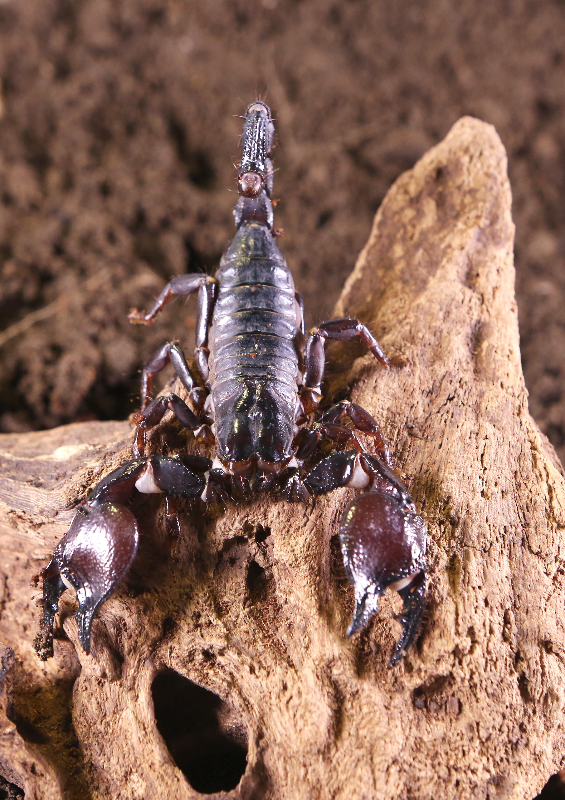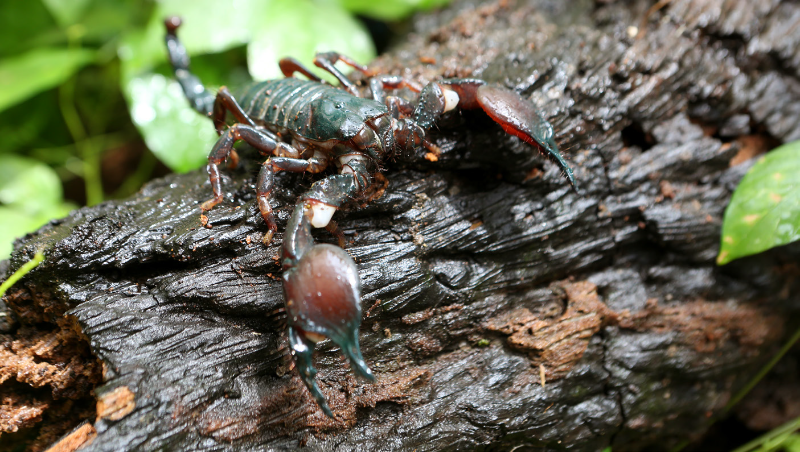Smaller than its close genetic cousin, the popular Emperor Scorpion or Pandinus imperator, the Red Clawed Scorpion is black with striking red-tinged claws, and backs up its fiery appearance with a more aggressive attitude than the Emperor.
To find out more about this stinger with an attitude, we interviewed scorpion keeper and expert John Valentin Chua.
“They are sometimes compared to the Emperor Scorpion,” he says, “but for me there is no comparison. Emperors are larger, and are known for being aggressive during breeding, but overall the Red Clawed Scorpion is just snappier than the Emps.”
Red Claws usually reach a size of 3 to 3 ½ inches, or 9-12 centimeters. “4 ½ inches, including the tail, is the maximum size. They usually live up to 8 years in captivity, sometimes longer.” Maybe this smaller size relative to the Emperor scorpion might be responsible for its testy attitude!
Not so Hot Scorpion
The Red Clawed Scorpion uses its signature claws to attack and kill its prey, which include insects, frogs, small mice, and other rodents. However, its elongated stinger is not used to catch prey. The Red Clawed Scorpion reserves its stinger for defense against larger animals, and it won’t hesitate to use it when threatened, often stinging the target repeatedly.
Fortunately, the sting of a Red Clawed Scorpion is relatively mild when compared to other scorpions, and are not fatal. “They’re venom level 1,” John explains, “and they have mild pincers. Just don’t poke at them with your fingers.” The Red Claw Scorpion’s sting is reportedly similar in intensity to a bee sting. “But they’re not deadly,” reassures John.

Keeping the Red Claw
To house a Red Claw, use a glass or plastic tank. As always, floor space is more important than height when it comes to keeping scorpions.
John recommends using a 2-3 inch cocopeat substrate, a hide, and a shallow water dish to help keep the humidity in the ideal range of 75-80%. Temperature should be between 24-28 degrees Celsius, or 75 to 80 degrees Fahrenheit. Misting or heat pads should not be necessary, as these scorpions are adapted to tropical climates.
The Red Clawed Scorpion also doesn’t have any special lighting needs. “No lighting needed,” John explains. “It’s totally up to the hobbyist. I just use a flashlight to view them.”
The Red Clawed Scorpion has little hairs on its claws which it uses as feelers, sensing any obstacles while it makes its way around in the dark. Try to avoid using dark-colored flooring inside the cage, as this scorpion’s dark red coloration may allow it to camouflage itself a little too effectively!“
As far as extra decoration goes, you can let your imagination run wild,” says John. Small objects like bark, driftwood, or rocks will allow the scorpion to hide. “Just don’t put anything too heavy that can potentially crush your pet!”
The Red Clawed Scorpion isn’t well suited to be kept communally, however, and doesn’t play nice with other scorpions, even other Red Claws. They can even be cannibalistic, which is why John keeps his Red Claws separate. He says, “As a general rule, from 2 instar to 5 instar, you can keep them together, but afterwards, you can’t. But they are also known to stay on their mom’s back until 2 instar!”B
Because of this aggressive streak, it can be very hard to breed Red Claw Scorpions. They rarely have suitable mating partners, and may instead fight each other to the death!

Eat Like a Pig
The Red Clawed Scorpion only requires feeding every 1-2 days for youngsters, while adults can be fed just twice a week. “We feed the scorplings mealworms and the occasional pinhead cricket,” says John, “and sub-adults to mature adults eat superworms, crickets, and dubia roaches.
”But while the Red Clawed Scorpion is fed relatively infrequently, that doesn’t mean it lacks a healthy appetite! “Red Claw Scorpions are like the pigs of the scorpion world, at least for the forest type,” John laughs. In fact, a hungry, snappy Red Claw is a healthy Red Claw. “This is unless the scorpion is in pre-molt,” John says, “which will make it sluggish and not want to eat.”
As with most scorpions, always remove uneaten food after feeding time.
A Healthy Grip
Although the Red Clawed Scorpion is among the easiest for novice hobbyists to keep, there are still some points that beginners should keep in mind, according to John. “Too much humidity can cause mycosis, which can kill them. Fungus can form near the book lungs.”
He advocates performing maintenance on your Red Clawed Scorpion once a week, and cleaning them in case of fungal build-up. “Put them in a container with wet tissue paper at the bottom and place it in a dark place. Clean the fungus with a cotton swab and water. Afterwards, place the scorpion in a dry environment for seven days.”
All of this might seem like a lot of trouble just for a pet, but John assures us that the Red Claw Scorpion makes a great novice pet, especially for beginners who are looking for something a bit feisty.
This story appeared as “The Emperor’s Feisty Cousin” in Animal Scene’s January 2017 issue.






